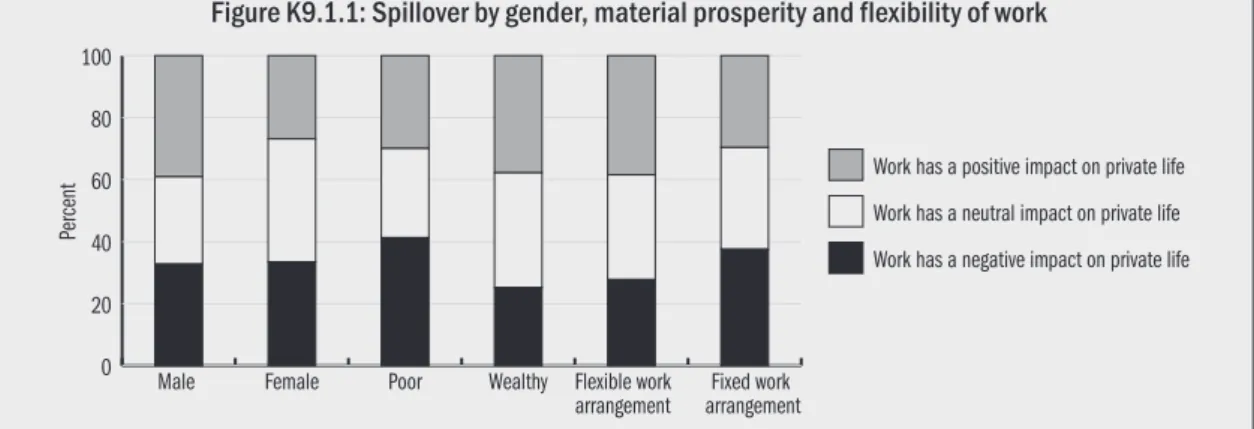0 20 40 60 80 100
Work has a positive impact on private life Work has a neutral impact on private life Work has a negative impact on private life
Fixed work arrangement Flexible work
arrangement Wealthy
Poor Female
Male
Percent
Figure K9.1.1: Spillover by gender, material prosperity and flexibility of work
K9.1 Spillover between worK and private life
171
K9.1 Spillover between work and private life* Beáta Nagy, Gábor Király & Márta Radó According to spillover theory, the experiences oneundergoes in one area of life positively or negatively influence (spill over to) another area. This spillover takes place in both directions: from private life to work and from work to private life. This study only explores the latter. Scientific papers (Greenhaus–
Powell, 2006) usually differentiate between affec- tive and instrumental spillover between work and family. Affective work-family spillover means taking home one’s feelings and attitudes from work, while the transfer of skills is called instrumental spillover.
In the work-family spillover literature, temporal and spatial flexibility receives special focus. Flex- ible work arrangements may significantly support the reconciliation of work and family obligations but also often make establishing and maintaining borders between various areas of life difficult.
At the same time, the flexibility of work is also a privilege that not all groups possess. Men tend to be able to choose their place of work more flexibly than women. Similarly, individuals with a higher social status are more likely to have a job that does not require permanent presence and, in this way, may be carried out remotely.
As part of the Omnibus survey by TÁRKI, the study titled Dilemmas and Strategies for Reconcil- ing Family and Work (K104707) by the Hungarian Scientific Research Fund explored, on a representa-
tive sample of the Hungarian adult population, in May 2014, to what extent work spills ove to private life, merging negative and positive spillover effects in one index. The analysis primarily concerned the association between gender and spillover. Figure K9.1.1 presents differences in spillover according to gender, financial well-being and flexibility of work. It shows that men, those enjoying financial well-being and those with more flexible work ar- rangements reported more positive spillover.
Then it was examined whether spillover is in- dependent of gender if the flexibility of work and financial well-being are controlled for (Figure K9.1.2). The model below shows that after control- ling for financial well-being and the flexibility of work, spillover is independent of gender.
In order to better understand the estimated pa- rameters of Figure K9.1.2, the categories of the var- iables should be examined in more detail. The gen- der variable assumes the value 1 if the respondent is male and the value 2 if the respondent is female.
The financial well-being variable assumes the value 1 if the respondent is poor and the value 2 if the respondent is rich. The ‘flexibility of work’ varia- ble assumes the value 1 if the respondent has flex- ible work arrangements and the value 2 if he or she has fixed work arrangements. Finally, the value of the spillover variable is 1 if work has a negative ef- fect on private life, 2 if it has a neutral effect and 3 if it has a positive effect.
* The detailed analysis in English is included in Radó et al. (2015).
Material wealth
Gender Spillover
Flexibility at work –0.21**
0.21**
–2.22**
2.22**
0.09**
–0.09** –0.09* –0.01* 0.10*
0.09* 0.01* –0.10* 0.23* –0.134* –0.10* –0.23* 0.134* 0.10*
Beáta Nagy, gáBor Király & Márta radó
172
Fugure K9.1.2: Parameters estimated for the path model
Note: The graphical presentation of the loglinear path model also shows the estimated parameters on arrows. Provided that a hypothetical graph has two nodes (A and B): if A and B were binary variables, only the non-redundant parameters related to the lower value would be provided. On the other hand, if two or three categories were related to A or B, all parameters would be provided. The estimated pa- rameters in the ith row and jth column of arrow AB, correspond to the ith value of A and the jth value of B respectively.
Significance levels *** p < 0.01, ** p < 0.05, * p < 0.1.
In conclusion, women are significantly less likely than men to have a job with a positive effect on family life, even though spillover is independent of gender, if financial well-beingand flexible work ar- rangement are controlled for. This is because wom- en are less likely to report financial well-being and flexible work arrangement, which would increase the possibility of positive spillover.
Our analysis revealed that gender disparities are caused and maintained by various social inequali- ties such as access to flexible work arrangements and subjective financial well-being. The results con- firmed that men are characterised by better subjec- tive financial well-being. The study also revealed that after controlling for subjective financial well- being, men are more likely to perceive they are able to influence their working conditions. The find- ings point out that equal access to flexible work ar- rangements and increasing the perceived financial well-being of women significantly improve the so- cial position of women both directly and indirectly.
References
Greenhaus, J. H.–Powell, G. N. (2006): When work and family are allies: A Theory of work-family enrich- ment. The Academy of Management Review, Vol. 31.
No. 1. pp. 72–92.
Radó, M.–Nagy, B.–Király, G. (2015) Work-to-Fam- ily Spillover: Gender Differences in Hungary. De- mográfia, Vol. 58. No. 5. English edition, pp. 39–64.
DOI:10.21543/DEE.2015.2.
